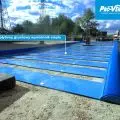{tag:studenci}, a graduate of the West Pomeranian University of Technology in Szczecin, decided to adapt the former modernist Cezas (School Supply Headquarters) building into Krateka. Her proposal is an attempt to realize the basic principles of the New European Bauhaus, using existing structures and giving new life to forgotten objects.
The presented project was created as a master's thesis under the direction of Krzysztof Bizio, PhD, professor at ZUT.
The author proposed a new function for the former building of the School Supply Headquarters in Szczecin
© Katarzyna Owsiany
history of Cezas
Cezas located at 1 Rayskiego Street in Szczecin was designed by Marian Rąbek in 1967. It originally served as a pavilion for the School Supply Headquarters, which is where its abbreviation in the name comes from. Years later, it was transformed into a retail and service pavilion, and it still serves that function today. One of the biggest problems that drew the attention of many residents was the ubiquitous advertising chaos. Caesars was entirely covered with advertising banners, becoming an icon of disrespectful modernist buildings. There is also an underpass in the area, commissioned in 1983, but due to the lack of an idea for its new function, it remains closed to residents, says Katarzyna Owsiany.
The planned expansion was to serve as a bracket between the former facilities
© Katarzyna Owsiany
idea for a modernist building
The author decided to cut off the area of the development of reagents degrading the space, hindering the introduction of a new function, which is Kreateka—a place connecting creativity, art and people. The main aspect influencing the form of the building was the desire to separate it from the parking lot located next to Caesars and to connect the building to the underpass. In turn, the planned expansion was intended to act as a kind of buckle between these objects.
Kreateka, projection of level 0
© Katarzyna Owsiany
The newly designed four-story building separates the urban interior from the existing development with a residential function, and is connected to Cezas. The designed building consists of two underground floors serving as an underground parking lot, which is an alternative to the existing above-ground one. The new designed part is a connecting element, both existing facilities and function.
Kreateka, north elevation
© Katarzyna Owsiany
green filter tower
On the site, the designer proposed a four-story green air filter tower. The tower is connected to the underpass and the new building and highlights the entrance to the Kreateka, while separating it from Wyzwolenia Street. The oxygenating tower is also a vertical garden, which is a green barrier that affects the air quality in the area.
The author introduced openwork elements
© Katarzyna Owsiany
reference to history
The urban interior was separated by openwork elements, referring to the finials of modernist buildings in Szczecin. For the designer it was extremely important to refer to the existing structure by introducing details taken from the stylistics of neighboring buildings—mostly modernist buildings from 1950-1970.
© Katarzyna Owsiany
The designer also introduced a new, openwork enclosure for Caesars, which is intended to temporarily protect the building and act as a bonding element between the building complex. The enclosure was designed as a separate structure and can be dismantled without interfering with the structure.
The under pass has been incorporated into level -1 of the new building and serves an exhibition function and is a place for promoting young artists from the creative industries sector.
different functions of the underpass
© Katarzyna Owsiany
CLT wood, hemp concrete and macramé panels
The architect designed the new facility using CLT wood post and beam construction supplemented with low-emission hemp concrete. Concrete is used in the CLT timber-framed frame structure. In the underground part, due to technical necessity, the author used recycled concrete.
The openwork structure is made of cotton macramé
© Katarzyna Owsiany
The openwork structure shielding Caesas and the oxygenation tower is made of recycled cotton macramé. After protecting it with beeswax from neighboring apiaries and making it resistant to the elements, the author made it a distinctive element of the design, also referring to the braids and macramé that were popular in Poland during the communist period.
The interiors were also made of natural, eco-friendly materials. The walls are covered with stained lime plaster, and the floors are clay staves.
penele made of recycled ceramics
In Szczecin and the surrounding area we can find many mosaics, which are a confirmation of the creative and abstract thinking of artists of the modernism period. They were meant to bring the viewer closer to art, which can be everyday art, says the ZUT graduate.
Wooden panels with a mosaic motif
© Katarzyna Owsiany
Referring to this treatment, the author introduced two-layer walls. The outer layer of the wall was designed as a wall of panels, which could be partially opening panels. The frames made of recycled wood are filled with ceramic waste from specific sets of ceramic elements in a random manner. The making of such panels would be possible by Crateka users and local residents. The designer believes that this would increase the sense of attachment to the facility, but also strengthen neighborhood ties.
The introduction of new elements is related to the development of the space and the characteristics of its functioning. The city should be seen as an organism that is alive, changing, changing its structure as it responds to the needs of its users. Kreateka is meant to be a creative place combining the old and the new. My project is to be a nod to the Szczecin architecture of the communist period, while at the same time taking a completely new look at the issues of shaping space or selecting materials," concludes Katarzyna Owsiany.










































































